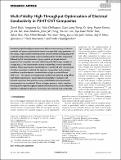| dc.contributor.author | Bash, Daniil | |
| dc.contributor.author | Cai, Yongqiang | |
| dc.contributor.author | Chellappan, Vijila | |
| dc.contributor.author | Wong, Swee Liang | |
| dc.contributor.author | Yang, Xu | |
| dc.contributor.author | Kumar, Pawan | |
| dc.contributor.author | Tan, Jin Da | |
| dc.contributor.author | Abutaha, Anas | |
| dc.contributor.author | Cheng, Jayce JW | |
| dc.contributor.author | Lim, Yee‐Fun | |
| dc.contributor.author | Tian, Siyu Isaac Parker | |
| dc.contributor.author | Ren, Zekun | |
| dc.contributor.author | Mekki‐Berrada, Flore | |
| dc.contributor.author | Wong, Wai Kuan | |
| dc.contributor.author | Xie, Jiaxun | |
| dc.contributor.author | Kumar, Jatin | |
| dc.contributor.author | Khan, Saif A | |
| dc.contributor.author | Li, Qianxao | |
| dc.contributor.author | Buonassisi, Tonio | |
| dc.contributor.author | Hippalgaonkar, Kedar | |
| dc.date.accessioned | 2021-12-15T17:11:46Z | |
| dc.date.available | 2021-12-15T17:11:46Z | |
| dc.date.issued | 2021 | |
| dc.identifier.uri | https://hdl.handle.net/1721.1/138489 | |
| dc.description.abstract | Combining high-throughput experiments with machine learning accelerates materials and process optimization toward user-specified target properties. In this study, a rapid machine learning-driven automated flow mixing setup with a high-throughput drop-casting system is introduced for thin film preparation, followed by fast characterization of proxy optical and target electrical properties that completes one cycle of learning with 160 unique samples in a single day, a >10× improvement relative to quantified, manual-controlled baseline. Regio-regular poly-3-hexylthiophene is combined with various types of carbon nanotubes, to identify the optimum composition and synthesis conditions to realize electrical conductivities as high as state-of-the-art 1000 S cm−1. The results are subsequently verified and explained using offline high-fidelity experiments. Graph-based model selection strategies with classical regression that optimize among multi-fidelity noisy input-output measurements are introduced. These strategies present a robust machine-learning driven high-throughput experimental scheme that can be effectively applied to understand, optimize, and design new materials and composites. | en_US |
| dc.language.iso | en | |
| dc.publisher | Wiley | en_US |
| dc.relation.isversionof | 10.1002/ADFM.202102606 | en_US |
| dc.rights | Creative Commons Attribution-Noncommercial-Share Alike | en_US |
| dc.rights.uri | http://creativecommons.org/licenses/by-nc-sa/4.0/ | en_US |
| dc.source | Other repository | en_US |
| dc.title | Multi‐Fidelity High‐Throughput Optimization of Electrical Conductivity in P3HT‐CNT Composites | en_US |
| dc.type | Article | en_US |
| dc.identifier.citation | Bash, Daniil, Cai, Yongqiang, Chellappan, Vijila, Wong, Swee Liang, Yang, Xu et al. 2021. "Multi‐Fidelity High‐Throughput Optimization of Electrical Conductivity in P3HT‐CNT Composites." Advanced Functional Materials, 31 (36). | |
| dc.contributor.department | Singapore-MIT Alliance in Research and Technology (SMART) | |
| dc.relation.journal | Advanced Functional Materials | en_US |
| dc.eprint.version | Author's final manuscript | en_US |
| dc.type.uri | http://purl.org/eprint/type/JournalArticle | en_US |
| eprint.status | http://purl.org/eprint/status/PeerReviewed | en_US |
| dc.date.updated | 2021-12-15T16:45:55Z | |
| dspace.orderedauthors | Bash, D; Cai, Y; Chellappan, V; Wong, SL; Yang, X; Kumar, P; Tan, JD; Abutaha, A; Cheng, JJW; Lim, Y; Tian, SIP; Ren, Z; Mekki‐Berrada, F; Wong, WK; Xie, J; Kumar, J; Khan, SA; Li, Q; Buonassisi, T; Hippalgaonkar, K | en_US |
| dspace.date.submission | 2021-12-15T16:45:58Z | |
| mit.journal.volume | 31 | en_US |
| mit.journal.issue | 36 | en_US |
| mit.license | OPEN_ACCESS_POLICY | |
| mit.metadata.status | Authority Work and Publication Information Needed | en_US |
